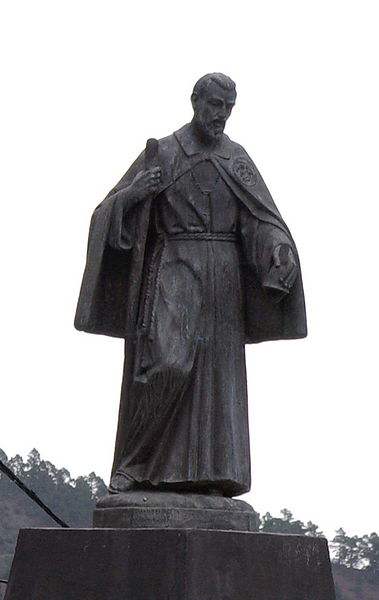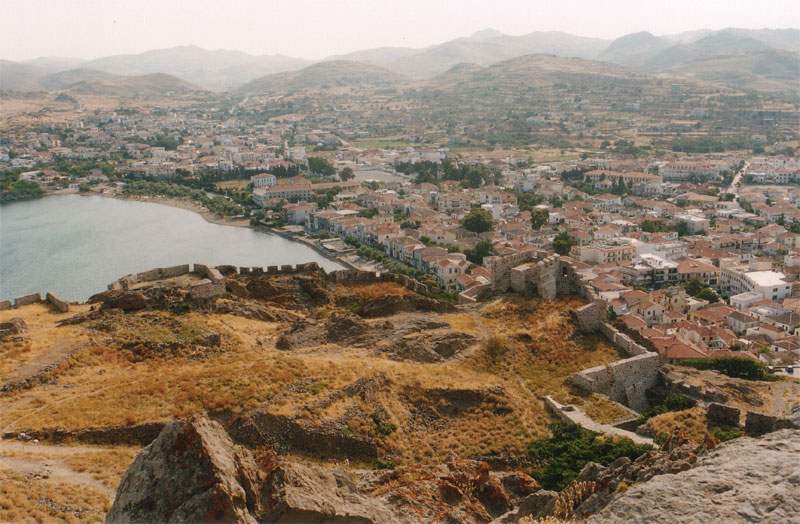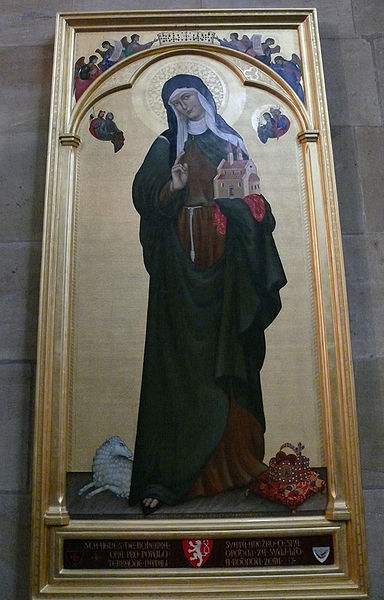Also see:
The Justice of God: Knights of the Cross
Bethlehemites: Military and Religious Orders
Bethlehemites: Military and Religious Orders
Bethlehemites
I. MILITARY ORDERS

Statue of St. Peter of Saint Joseph Betancur in Tenerife, Spain.
There were two military orders dedicated to Our Lady of Bethlehem and known under the name of Bethlehemites. Mathew Paris calls attention to the former in his “Grande Chronique” (tr. Huillard-Bréholles, Paris, 1840, 8vo, III, 300) where he mentions that Henry III of England authorized them to open a house in a suburb of Cambridge (1257); but he leaves us in complete ignorance as to their founder, where they originated, and their history. We only know that their habit was similar to that of the Dominicans and that a red star, whose five rays emanated from an azure centre, decorated the breast of their cape. This was in commemoration of the star that appeared to the Magi and led them to Bethlehem. Nothing further is known of this military order. There was an order of knights whose members wore a red star on their costume and who might have been called Bethlehemites because of having a house in Bethlehem at the time of the Crusades; this was the Military Order of Crusaders of the Red Star (Ordo militaris crucigerorum cum rubeâ stellâ). They came from Palestine to Bohemia in 1217, and Blessed Agnes of Bohemia confided two hospitals to their charge. They have since remained in that country where they devote themselves to the care of the sick, to education, and to the various works of the ecclesiastical ministry.

Island of Lemnos, Greece
After the taking of Constantinople by the Turks (1453), Pius II founded under the patronage of Our Lady of Bethlehem an order of knights for the defence of the Island of Lemnos which Cardinal Louis, Patriarch of Aquileia, had recaptured from Mohammed II. The island was to be their headquarters whence they were to oppose the attacks of the Moslems by way of the Ægean Sea and the Hellespont. The order was composed of brother-knights and priests governed by an elective grand-master. The white costume worn by the members was decorated with a red cross and the rule prescribed for them was very similar to that of the
Knights of St. John of Jerusalem. The pope installed this community 18 January, 1459, and, that their needs might be supplied, turned over to them the property and revenues of the orders of
St. Lazarus, of Sainte-Marie du Ch teau des Bretons, of Bologna, of the
Holy Sepulchre, of Santo Spirito in Sassia, of St. Mary of the Crossed Friars, and of St. James of Lucca, all of which were suppressed for this purpose. Pius II alluded in a Bull to this foundation and the bravery of its knights, but the second capture of Lemnos by the Turks rendered the institution useless. Thus the order of Our Lady of Bethlehem was suppressed almost as soon as founded and those orders whose goods the pope had transmitted to it were re-established.

St. Agnes of Bohemia
HOSPITALERS
The hospitaler Bethlehemites, or Belemites, were founded by the Ven. Pedro de Betancourt. A descendant of the celebrated Juan de Betancourt, who, early in the fifteenth century, achieved the conquest of the Canary Islands for Henry III of Spain, Pedro was born at Villaflora on the Island of Teneriffe in 1619. From childhood he led a pious, austere life and in 1650 left family and country, thus carrying out his desire of going to the West Indies. During the following year he reached Guatemala, the capital of New Spain, where he intended to prepare for the priesthood that later he might go forth and evangelize Japan. However, three years of unsuccessful study at a Jesuit college led him to abandon this idea and, after holding the position of sacristan for a while in a church dedicated to the Blessed Virgin, he rented a house in a suburb of the city called Calvary, and there taught reading and catechism to poor children. But this charitable work did not furnish sufficient outlet for his zeal. The condition of the sick poor excited his compassion and he sheltered them in his home which he converted into a hospital. His zeal elicited benefactions from those around him and the bishop and governor supplied him with all the conveniences he required. Several individuals provided for the purchase of the houses surrounding the one he then occupied and on their site was erected a hospital in which this servant of God could labour to better advantage. He himself worked with the masons. The hospital was thoroughly equipped and stocked and even offered an opportunity for the religious installment of those who tended the sick. The institution was placed under the patronage of Our Lady of Bethlehem. Helpers soon joined Pedro de Betancourt and at length was formed a congregation of brothers generally known as Bethlehemites and so called on account of their house. But the care of the sick did not totally absorb their attention; they likewise lent their assistance in the two other hospitals of the city and Pedro continued to befriend poor children. The prisoners also excited his compassion. Every Thursday he begged for them through the city and visited them in their cells. The neglected souls in purgatory were also the objects of his solicitude and at the principal gates of the city he founded two hermitages, or chapels, wherein religious of his community begged, so that masses might be celebrated for the souls of the deceased. He himself would travel the streets at night ringing a bell and recommending these souls to be prayed for. His devotion to the Blessed Virgin was inspiring and during a novena of preparation for the feast of the Purification his religious, with arms extended in the form of a cross, recited the rosary in their chapel at midnight in the midst of a great throng. In 1654 he made a vow to defend the Immaculate Conception even at the peril of his life. He died, exhausted by labour and penance, 25 April, 1667, at the age of forty-eight. His funeral was impressive and at the request of the Capuchin Fathers he was buried in their church where, for a long time, his remains were held in veneration.

Before establishing his Guatemala hospital Pedro de Betancourt had become affiliated with the Third Order of St. Francis, adopting its religious garb which he still retained after founding his congregation. He personally trained his first disciples and had no wish to organize a community, but simply to establish his hospital. He sent Brother Anthony of the Cross to Spain to solicit the king’s approbation of the work. The favour was granted, but Pedro died before the messenger’s return. From that time the community prospered, beginning with the extension of the hospital and the erection of a beautiful church. Brother Anthony, who assumed the government, drew up constitutions which he submitted to the bishop of the diocese for approval and it was at this juncture that the Capuchins requested him to make some alterations in the habit worn by his religious. A free school for poor children was already connected with the Bethlehem hospital, a feature of all new foundations. One of these was soon undertaken by Brother Anthony of the Cross who sent two of his community to Peru where they were very favourably received by the viceroy to whom he had recommended them. Doctor Antoine d’Arvila gave them the Hospital of Notre Dame du Carmel which he was then establishing at Lima and afterwards solicited admission among them. In 1672 Brother Roderick of the Cross obtained the confirmation of this establishment by the King of Spain and it was also through his efforts that Pope Clement X confirmed the congregation and its constitutions (1673). After his return to America this religious founded the Hospital of St. Francis Xavier in Mexico and those of Chachapoyas, Cajamarca, and Trujillo, going back to Spain in 1681 to secure the confirmation of these new institutions. The Council of the Indies assigned the hospital of Lima an income of 3,000 crowns. The Bethlehemites, because of making only simple vows, remained under diocesan jurisdiction from which they wished, however, to be freed so that their congregation might be converted into a regular religious order bound by solemn vows. The Spanish court did not approve this plan and at first the Holy See was not favourable to it, but due chiefly to the influence of Cardinal Mellini, former nuncio at Madrid, Roderick of the Cross at length overcame all difficulties and in the Bull of 26 March, 1687, Innocent XI authorized these religious to make the three solemn vows according to the rule of St. Augustine and to have a superior-general, and granted them all the privileges of the Augustinian friars and convents. Later, Clement XI renewed this authorization and these favours, adding thereunto the privileges of the mendicant orders, of the Regular Clerks, of the Ministers of the Sick, and of the Hospitallers of Charity of St. Hippolytus (1707).
Meanwhile the order was multiplying its foundations in Latin America and was established in Arequipa, Cuzco, Santiago de Cuba, Puebla, Guadalajara, Guanajuato, Dajaka, Vera Cruz, Havana, Santiago de Chile, Buenos Ayres, and Guatemala la Nueva. A school for poor children was connected with every hospital and the pious, devoted lives of these religious won them esteem and gratitude. They were especially admired during the plague of 1736, a fact unanimously acknowledged by the writers who describe the condition of Latin America in the eighteenth century. But this did not prevent their suppression, as well as that of all other religious, in 1820. At that time their superior-general resided in Mexico and the Bethlehemites were scattered throughout two provinces, that of Peru including twenty-two houses and that of New-Spain, eleven. To the ordinary religious vows they added that of caring for the sick even at the risk of their own lives. In 1688 Brother Anthony of the Cross, with the help of a pious woman, Marie Anne del Gualdo, founded at Guatemala a community of Bethlehemite nuns and a hospital exclusively for women. These nuns were cloistered and observed the same rule as the men and they, too, were suppressed in 1820.
H LYOT, Histoire des ordres monastiques, III, 355-356; VIII, 371-372; BARONIUS,Annales ecclesiastici (Lucca, 1753), XXIX, 179-180; HEIMBUCHER, Die Orden und Kongregationen, I, 497-498; DE MONTALVO, Vida del venerable Pedro de San Jos Betancourt (Rome, 1718); EYZAGUIRRE, Los intereses cat licos en Am rica (Paris, 1859), II, 304-306, 408-410.
J.M. BESSE (Catholic Encyclopedia)












No comments:
Post a Comment